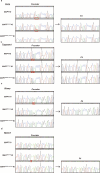In vivo hyperphosphorylation of tau is associated with synaptic loss and behavioral abnormalities in the absence of tau seeds
- PMID: 39719507
- PMCID: PMC11802456
- DOI: 10.1038/s41593-024-01829-7
In vivo hyperphosphorylation of tau is associated with synaptic loss and behavioral abnormalities in the absence of tau seeds
Abstract
Tau pathology is a hallmark of several neurodegenerative diseases, including frontotemporal dementia and Alzheimer's disease. However, the sequence of events and the form of tau that confers toxicity are still unclear, due in large part to the lack of physiological models of tauopathy initiation and progression in which to test hypotheses. We have developed a series of targeted mice expressing frontotemporal-dementia-causing mutations in the humanized MAPT gene to investigate the earliest stages of tauopathy. MAPTInt10+3G>A and MAPTS305N;Int10+3G>A lines show abundant hyperphosphorylated tau in the hippocampus and entorhinal cortex, but they do not develop seed-competent fibrillar structures. Accumulation of hyperphosphorylated tau was accompanied by neurite degeneration, loss of viable synapses and indicators of behavioral abnormalities. Our results demonstrate that neuronal toxicity can occur in the absence of fibrillar, higher-order structures and that tau hyperphosphorylation is probably involved in the earliest etiological events in tauopathies showing isoform ratio imbalance.
© 2024. The Author(s).
Conflict of interest statement
Competing interests: T.E. serves as a Representative for Phenovance LLC, which provides commercial service using IntelliCage. T.C.S. serves as an Executive Consultant for RIKEN BIO Co. Ltd., which sublicenses App knock-in mice to for-profit organizations. K.E.D. is a board member of Ceracuity LLC. H.Z. has served at scientific advisory boards and/or as a consultant for Abbvie, Acumen, Alector, Alzinova, ALZPath, Annexon, Apellis, Artery Therapeutics, AZTherapies, CogRx, Denali, Eisai, Nervgen, Novo Nordisk, Optoceutics, Passage Bio, Pinteon Therapeutics, Prothena, Red Abbey Labs, reMYND, Roche, Samumed, Siemens Healthineers, Triplet Therapeutics and Wave, has given lectures in symposia sponsored by Cellectricon, Fujirebio, Alzecure, Biogen and Roche, and is a cofounder of Brain Biomarker Solutions in Gothenburg AB (BBS), which is a part of the GU Ventures Incubator Program (outside submitted work). The other authors declare no competing interests.
Figures


















References
-
- Hutton, M. et al. Association of missense and 5′-splice-site mutations in tau with the inherited dementia FTDP-17. Nature393, 702–705 (1998). - PubMed
-
- Poorkaj, P. et al. Tau is a candidate gene for chromosome 17 frontotemporal dementia. Ann. Neurol.43, 815–825 (1998). - PubMed
-
- Langworth-Green, C. et al. Chronic effects of inflammation on tauopathies. Lancet Neurol.22, 430–442 (2023). - PubMed
MeSH terms
Substances
Grants and funding
LinkOut - more resources
Full Text Sources
Molecular Biology Databases

